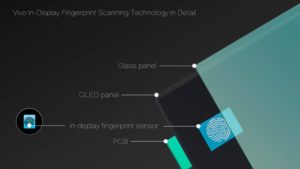For many, mobile devices have become a central key to way we move, live, work, travel, manage our finances, and co-ordinate our lives. With an increasing amount of sensitive material being stored on our phones, consumers value their privacy and protection more than ever.
Mobile device OEMs are reacting to this consumer demand by working to supply creative and dynamic biometric solutions to ensure secure and efficient access to your phone. Here are three examples of today’s state-of-the-art biometric phones.
iPhone X and Face ID
 Apple’s iPhone X comes with the company’s ‘Face ID’ security feature, which allows users to unlock their phones with a simple glance. The technology generates a 3D depth map of the user’s face using multiple sensors in the device. The biometric authentication allows the user to:
Apple’s iPhone X comes with the company’s ‘Face ID’ security feature, which allows users to unlock their phones with a simple glance. The technology generates a 3D depth map of the user’s face using multiple sensors in the device. The biometric authentication allows the user to:
- Conduct facial scans in various lighting conditions thanks to its use of infrared light
- Update with age and changing appearance
- Use when wearing sunglasses, hats, or scarves
- Choose face-based verification for App Store and iTunes purchases, as well as authentication for third party apps currently using Touch ID.
Apple is an industry leader in consumer biometric authentication and with competitors using 2D facial mapping, it’s projected many devices will follow Apple’s trend and introduce the 3D mapping into their devices.
Samsung Galaxy S9 and Intelligent Scan
 Similar to the iPhone X, the Samsung Galaxy S9 and the S9+ include a dual camera systems that allows for depth perception and leverage AI allowing for users’ facial expressions to be mapped out and turned into animated emojis. The naming of these avatar emojis is still yet to be universal, with Samsung calling them ‘AR Emojis’ and Apple preferring ‘Animojis’.
Similar to the iPhone X, the Samsung Galaxy S9 and the S9+ include a dual camera systems that allows for depth perception and leverage AI allowing for users’ facial expressions to be mapped out and turned into animated emojis. The naming of these avatar emojis is still yet to be universal, with Samsung calling them ‘AR Emojis’ and Apple preferring ‘Animojis’.
Emojis aside, the devices biometric technology relies on these imagining capabilities to enable to the new user authentication system called Intelligent Scan which combines improved facial recognition with the company’s signature iris scanning provided by Princeton Identity. Samsung’s biometric authentication system also features the fingerprint recognition, providing a multimodal approach allowing the consumer to decide on the biometric access they wish to use to access their device.
The S9 and S9+ are slated to hit the market on March 16th.
Vivo X20 Plus UD and the Clear ID fingerprint sensor

Vivo has developed world’s first in-display fingerprint scanning smartphone, emphasizing the solution’s ability to accommodate full-size displays and the convenience of maintaining a front-facing fingerprint scanning system, which many consumers prefer.
Based on Synaptics’ Clear ID sub-display optical sensor, he fingerprint biometrics system on the Vivo X20 Plus UD is designed to prompt the user for a fingerprint scan with a visual cue on the screen whenever authentication is required. This prompt can appear even when the screen is off and will disappear when no longer needed allowing for full screen access. And while the in-display technology is currently only available in the one handset, Vivo demonstrated novel concepts of how on-screen fingerprint scanning may evolve at Mobile World Congress.
*
A diverse selection of biometric solutions of mobile devices are becoming readily available. It remains to be seen whether multimodal biometric applications will become the way we access our phones, or whether there will be a preferred biometric access that becomes the standard application when it comes to consumer mobile biometric access.

Follow Us